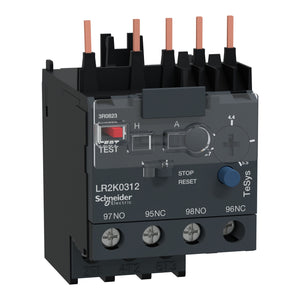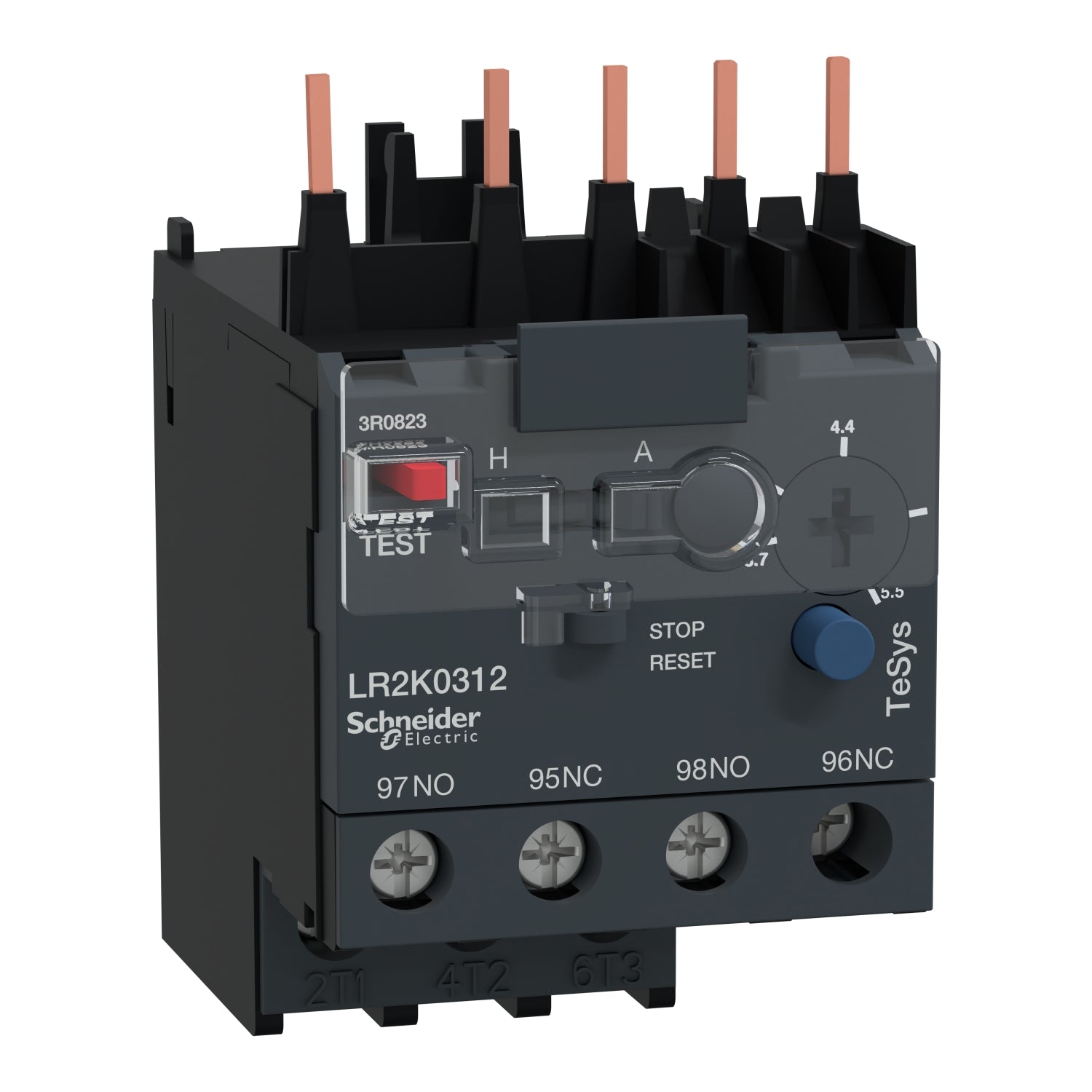

LR2K0312 | Schneider Electric Differential Thermal Overload Relays
- Regular price
- $64.00
- Sale price
- $64.00
- Regular price
-
Couldn't load pickup availability
Do you need help?
Product Description P/N: LR2K0312
Description
The LR2K0312 is a differential thermal overload relay belonging to the TeSys K series, specifically engineered to work in conjunction with TeSys K contactors to form a motor starter assembly. These relays serve to detect overcurrents within the motor's power lines. Upon detecting an overcurrent, the relay, in tandem with the contactor, disengages power to the motor, mitigating potential damage to the motor windings.
Featuring an adjustable trip current rating ranging from 3.7 to 5.5 amperes, calibrated per Class 10A, this overload relay offers precise protection tailored to specific motor requirements.
Technical Specifications
|
Part Number |
LR2K0312 |
|
Category |
Contactors & Starters |
|
Subcategory |
Solid State Overload/Relay |
|
Product or Component Type |
Differential thermal overload relay |
|
Device short name |
LR2K |
|
Relay application |
Motor protection |
|
Thermal overload class |
Class 10A IEC 60947-4-1 |
|
Thermal protection adjustment range |
3.7…5.5 A |
|
Network Frequency |
≤ 400 Hz |
|
Auxiliary contact composition |
1 NO + 1 NC |
|
[Ith] conventional free air thermal current |
6 A |
|
Signaling circuit |
Trip indicator (Yellow) |
|
[Uimp] rated impulse withstand voltage |
6 kV |
|
Power dissipation per pole |
2 W |
|
Phase failure sensitivity |
Yes IEC 60947-4-1 |
|
Local signaling |
Trip indicator (Yellow) |
|
Height |
2.28 in (58 mm) |
|
Width |
1.77 in (45 mm) |
|
Depth |
2.56 in (65 mm) |
|
Net Weight |
0.32 lb(US) (0.145 kg) |
|
IP degree of protection |
IP2X conforming to IEC 60529 |
|
Ambient air temperature for operation |
-4…131 °F (-20…55 °C) without derating IEC 60947 |
|
Ambient Air Temperature for Storage |
-40…158 °F (-40…70 °C) |
|
Operating altitude |
6561.68 ft (2000 m) without derating |
|
Fire resistance |
1562 °F (850 °C) IEC 60695-2-1 |
Information About LR2K0312
The LR2K0312 is a differential thermal overload relay designed as part of the TeSys K product line. It is intended for use alongside TeSys K contactors to create motor starters. These relays are engineered to detect overcurrents in the lines supplying power to the motor. Upon detecting an overcurrent, the overload relay collaborates with the contactor to interrupt the power supply to the motor, thereby minimizing damage to the motor windings.
This particular overload relay boasts an adjustable trip current rating ranging from 3.7 to 5.5 amperes. The trip current rating is calibrated according to Class 10A standards. Installation is facilitated through mounting on a DIN rail, separate from the contactor. For proper installation, it requires the use of a terminal block (LA7K0064), which must be ordered separately.
Manufacturer information
Schneider Electric, a global leader in energy management and automation, offers innovative solutions for efficiency and sustainability. With a diverse portfolio spanning power distribution, automation, and renewable energy, Schneider Electric is committed to shaping a more connected and sustainable future.
Description
The LR2K0312 is a differential thermal overload relay belonging to the TeSys K series, specifically engineered to work in conjunction with TeSys K contactors to form a motor starter assembly. These relays serve to detect overcurrents within the motor's power lines. Upon detecting an overcurrent, the relay, in tandem with the contactor, disengages power to the motor, mitigating potential damage to the motor windings.
Featuring an adjustable trip current rating ranging from 3.7 to 5.5 amperes, calibrated per Class 10A, this overload relay offers precise protection tailored to specific motor requirements.
Technical Specifications
|
Part Number |
LR2K0312 |
|
Category |
Contactors & Starters |
|
Subcategory |
Solid State Overload/Relay |
|
Product or Component Type |
Differential thermal overload relay |
|
Device short name |
LR2K |
|
Relay application |
Motor protection |
|
Thermal overload class |
Class 10A IEC 60947-4-1 |
|
Thermal protection adjustment range |
3.7…5.5 A |
|
Network Frequency |
≤ 400 Hz |
|
Auxiliary contact composition |
1 NO + 1 NC |
|
[Ith] conventional free air thermal current |
6 A |
|
Signaling circuit |
Trip indicator (Yellow) |
|
[Uimp] rated impulse withstand voltage |
6 kV |
|
Power dissipation per pole |
2 W |
|
Phase failure sensitivity |
Yes IEC 60947-4-1 |
|
Local signaling |
Trip indicator (Yellow) |
|
Height |
2.28 in (58 mm) |
|
Width |
1.77 in (45 mm) |
|
Depth |
2.56 in (65 mm) |
|
Net Weight |
0.32 lb(US) (0.145 kg) |
|
IP degree of protection |
IP2X conforming to IEC 60529 |
|
Ambient air temperature for operation |
-4…131 °F (-20…55 °C) without derating IEC 60947 |
|
Ambient Air Temperature for Storage |
-40…158 °F (-40…70 °C) |
|
Operating altitude |
6561.68 ft (2000 m) without derating |
|
Fire resistance |
1562 °F (850 °C) IEC 60695-2-1 |
Information About LR2K0312
The LR2K0312 is a differential thermal overload relay designed as part of the TeSys K product line. It is intended for use alongside TeSys K contactors to create motor starters. These relays are engineered to detect overcurrents in the lines supplying power to the motor. Upon detecting an overcurrent, the overload relay collaborates with the contactor to interrupt the power supply to the motor, thereby minimizing damage to the motor windings.
This particular overload relay boasts an adjustable trip current rating ranging from 3.7 to 5.5 amperes. The trip current rating is calibrated according to Class 10A standards. Installation is facilitated through mounting on a DIN rail, separate from the contactor. For proper installation, it requires the use of a terminal block (LA7K0064), which must be ordered separately.
Manufacturer information
Schneider Electric, a global leader in energy management and automation, offers innovative solutions for efficiency and sustainability. With a diverse portfolio spanning power distribution, automation, and renewable energy, Schneider Electric is committed to shaping a more connected and sustainable future.


